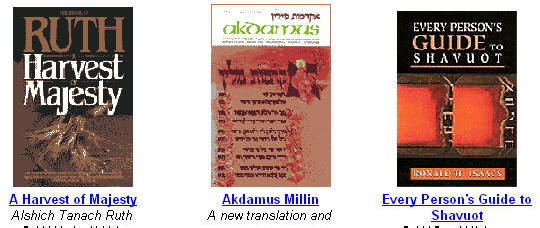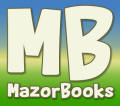
|
| • Holiday Gifts |
| Holiday Central > Shavuot > Customs and Traditions |
By: Rivka C. Berman, Contributor
Click Here for More Holiday Articles

Commemorating the revelation at Mt. Sinai inspired many of Shavuot’s customs. Many also tie into the agricultural meaning of the day.
- Reading the Scroll of Ruth
- Eating Dairy Foods
- Beyond Cheesecake and Blintzes
- Special Breads
- Tikkun Layl Shavuot
- Greenery
- Confirmation
The Scroll of Ruth
Ruth is the most celebrated Jew-by-choice. Her story is recounted in
the Scroll of Ruth. One of the reasons this story is read on Shavuot is
because the day the Jewish people received the Torah was a sort of mass
conversion of a People. (Click here for a
short overview of the Scroll of Ruth.)
Harvest time is the setting of the Ruth’s story – just right for reading at Shavuot which is the Chag Hakatsir, harvest festival.
Eating Dairy Food
Since most other Jewish holidays are drenched in brisket and chicken
soup, the tradition to eat dairy on Shavuot comes as a welcome change.
There are many, many reasons offered for this custom. (Click
here for a Cheese Cake Recipe)
- Once the Jews accepted the Torah, they became obligated in the laws
of kosher. But since they were not yet familiar with the laws regarding animal slaughter,
they ate dairy.
- Receiving the Torah was a form of rebirth. We celebrate this newness
by consuming baby food. Namely, milk.
- Shavuot coincided with the time when the lambs and calves born in
the spring would be suckling. Therefore an abundance of dairy products
were available.
- Legend has it that the Jewish people were at Sinai for so long that
all their milk soured and turned into cheese.
- In the Torah the Jewish people are promised a "Land flowing
with milk and honey." Dairy meals recall this lyrical description
of Israel.
- The Hebrew word for milk, chalav, has the numerical value of 40, symbolizing the number of days Moses was on Mt. Sinai. Chalav is spelled chet (numerical value, 8), lamed (30), and vet (2).
Beyond Cheesecake and Blintzes
Kreplach
Funny how many three-part foods are associated with Jewish life.
(Tri-cornered hamantaschen/oznei Haman on Purim and the three
matzas on the traditional seder plate.) Cheese-filled kreplach,
three-cornered Jewish ravioli, are served at some Shavuot feasts to
represent the three parts of the Jewish Bible: Torah, Prophets and
Writings.
Special Breads
Shavuot’s sacrificial rites were remarkable for their inclusion of
two leavened loaves along. Most other sacrifices were accompanied by
matzah. This may be the seminal reason behind the various breads
associated with Shavuot.
Ukrainian Jews bake loaves studded with a little ladder shaped from extra dough. The ladders symbolize Moses’ ascent to Sinai. Ladders with five rungs recall the five books of the Torah: Genesis, Exodus, Leviticus, Numbers, and Deuteronomy. Seven rungs on a bread ladder are symbols of the seven weeks between Passover and Shavuot.
Some Sephardic Jews bake a seven layered bread called siete cielus, or seven heavens, based on the Midrash that Moses ascended to heaven to learn the Torah.
Greek Jews customarily bake a honey-and-yogurt bread. Throughout the rest of the year, Jewish custom frowns on baking dairy breads because of the potential for being accidentally used with a meat meal.
German Jewish specialties included kauletsch, cheese challah.
Hungry yet?
Tikkun Leil Shavuot
Midrashic legends scold the Jewish people for sleeping the night
before they received the Torah. Apparently God had to sound a shofar
blast and bring thunder and lightning to wake them up. This is one
reason why 16th century kabbalists in Safed, Israel, created Tikkun
Leil Shavuot, repairing the eve of Shavuot. Originally the Tikkun
consisted of readings from the bible, the talmud and the kabbalah, which
would be studied all night long.
From another perspective, receiving the Torah at Sinai was like a marriage between God and the Jewish people – with Moses as matchmaker and the Torah as the ketubah, marriage certificate. Like an antsy bride, we have trouble falling asleep the night before our wedding. To symbolically prepare ourselves we learn Torah to review the highlights of our sacred relationship.
Tikkun Leil Shavuot programs may be sponsored by your synagogue. Times vary, but the sunset to dawn model is not usually followed. (Popular formats: 7:00 p.m.- 12:00 a.m., 8:30-11:15 p.m., and 8:30-10:00 p.m.)
Study can be structured, in the form of a lecture or a discussion group. Participants can study in chavrutot, pairs, individually or in groups. It’s up to you.
Like the midrashic association of the Mt. Sinai event with a marriage ceremony, Reform rabbis have created a mock wedding ceremony as a closing ceremony for a Shavuot night study session.
In the ceremony, representatives from the community are chosen to stand under a chuppah, marriage canopy with the Torah. A passage is read from the Torah (Deuteronomy 29:9-14) as a statement of recommitment to accept the Torah. "You stand on this day all of you before the Lord… to enter the covenant."
In a brief responsive reading the assembly repeats the words that the Jewish People used to accept the Torah: Naaseh V’nishma, we will do and we will learn. Then a variation of the ketubah is read. (God plays the groom, Jews are the bride, and Moses gets an honorable mention as the shadchan, matchmaker.) Afterward the Ten Commandments are read. Like a marriage ceremony, the Shavuot ceremony ends with a stomp on a glass and a rousing round of Mazal Tov u’Siman Tov! May it be good luck and a good omen!
Guided Imagery for Leil Shavuot
Rabbi Dov Peretz Elkins wrote "A Guided Shavuot Imagery"
distributed by the Hebrew Union of American Congregations (HUAC) for use
at Tikkun Leil Shavuot evenings. The exercise is read to help
participants transform their learning into a personally relevant and
comfortable experience.
"Think about how the whole world is sleeping while you and your friends and Jewish groups like us in many other cities and lands are studying words of Torah. How rich is our tradition! How fortunate you feel" – from "A Guided Shavuot Imagery"
Greenery
Decorating the synagogue and home with greenery and flowers is
another Shavuot tradition. Midrashic lore describes how Mt. Sinai
suddenly flowered in anticipation of the Torah’s arrival. Since
Shavuot was also a harvest holiday the sheaths and boughs would be signs
of a successful growing season.
Mystics add another reason for this practice: G-d responded to Adam and Eve’s partaking of the Tree of Knowledge by dulling all the senses involved in their sin. Only the power of scent was left intact. (Evidence: One whiff of a waxy crayon evokes kindergarten memories; a mothball’s pungency lands you straight into a grandparent’s coat closet.) By giving the Torah, G-d renewed the world and began repairing the breach by tugging on the one sensual thread, scent, that had never been severed.
Rabbi Nachman of Breslov (1772-1810) is known for weaving kabbalistic mysteries and practical advice into fantastic stories. A fitting occupation for the great-grandson of the Baal Shem Tov, the originator of chassidic thought. R’ Nachman advocated hitbodedut, secluded prayer in one’s native language. Before the morning prayers on Shauvot, he was known to run through the green fields surrounding his adopted hometown of Uman, Ukraine. "If we would only merit to hear the voice of each blade of grass singing praise to the Creator, then we would merit to sing a true song to G-d."
Confirmation
At some temples, confirmation is known as "Kabbalat Torah,"
the words mean "accepting the Torah." This is the intent of
the ceremony, to demonstrate the teens’ acceptance of Judaism.
Confirmation/Kabbalat Torah is celebrated by groups of teens, unlike the
individual bar/bat mitzvah ceremony.
Often confirmation is scheduled to coincide with the Shavuot holiday, which commemorates the giving of the Ten Commandments. It’s a good time of year for this celebration. First, Shavuot falls out around June – the month of graduation ceremonies. Second, the symbolism of receiving the Torah is highly appropriate for the confirmation because it marks a deeper acceptance of Judaism.
Confirmation is generally takes place between ages 15 to 18.
Ceremonies vary. Confirmands might lead a portion of the Friday night services. They may be asked to write a presentation, such as one on the theme "Where we are. Where we are going." One goal of confirmation is to keep teenagers involved in synagogue life, so they may be given responsibilities/privileges such as handing out the prayer books, changing the page number display during services, or acting as ushers.

Mazor Guide to Shavuot, Pentecost, brings you much more about the holiday, its meaning and its traditions... See the links below.
- Shavuot Home
- Shavuot Purpose and Meaning
- Shavuot Customs and Traditions
- Shavuot Celebrations and Blessings
- The Story of Ruth and Naomi
- Reading Ruth: Rhyme and Reason.
- Shavuot Hidden Facts and Messages
- Shavuot and the Number Six
- Shavuot Cookbooks
MazorGuide Recommended Reading
 RUTH
- ArtScroll Edition
RUTH
- ArtScroll Edition
A new translation with a commentary
anthologized from Talmudic, Midrashic and Rabbinic sources
The ArtScroll Series presents the comments of the classic giants of ancient and contemporary times in a logical, comprehensible manner, like a master teacher on an exciting voyage of intellectual discovery.
- Entire Hebrew text reset in clear modern type
- Flowing English translation
- Commentary anthologized from 2,000 years of Talmudic and Rabbinic sources
- Overviews exploring the hashkafah/philosophical background of each volume.
To Be A Jew: A Guide To Jewish Observance In Contemporary Life
(Paperback)
by Hayim H. Donin (Author)
|
|
|
|

|
| • Holiday Gifts |
|
|
 |
| • Celebrations Gifts |
|
·
Wedding Gifts · Bar Mitzvah Gifts · Baby Gifts · Jewish Books at Great Prices |
KOSHER BY DESIGN Amazing New Kosher Cookbook. BUY |
Mazor Guides: Wealth of Information and Resources
- Mazor Guide - The Ultimate Guide to
Living Jewish -
- Guide to Jewish
Holidays -
-
Bar Mitzvah
and Bat Mitzvah Guide -
-
Guide to a
Jewish Wedding -
-
Guide to Jewish Celebrations -
-
Guide to Kosher Living -
- Infertility and
Judaism: A Guide -
- The Get (Gett)
- the Jewish Divorce: A Guide -
- Zei
Gezunt: Jewish Perspective on Health -
- Jewish Genetic Diseases -
-
Death and Mourning in
Judaism -
Copyright 1998-2024 MazorNet, Inc.
| http://www.MazorGuide.com | http://www.MazorBooks.com | http://www.Kosher-Directory.com | http://www.JewishCelebrations.com





